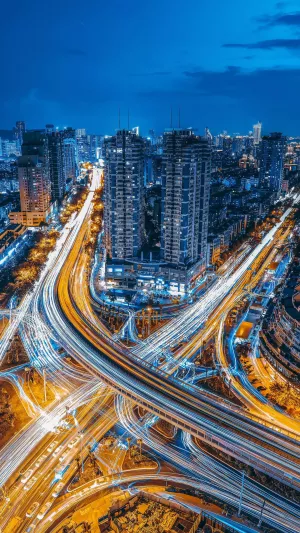Traveling in this vertical world is a perspective that people are accustomed to it. But if you overlook from a high altitude, what is presented in front of us will be an extremely complicated but extremely stunning geometric world.
One of the founders of French planned thinkers and one of the founders of modern architecture, Lebusier published the book "Tomorrow City and its Planning" in 1922. In this book, Lebusier proposed the idea of multi-layer and high-speed highways in urban planning.
The idea was very forward at the time. Now the idea of three-dimensional intersection has already been used in the city's major highways. The giant overpasses that stand in the city are the optimization of contemporary urban aesthetics, as well as the embodiment of geometric aesthetics.
The overpass is to separate the intersecting roads in vertical space so that the traffic flow can realize the effect of non-interference on different elevations. Simply put, it is a way to avoid traffic congestion and ensure the orderly running of vehicles.
The overpass is both a bridge and a road, a perfect project that traverses the city's steel forest. It is like the blood vessels in the human body, overlapping and interweaving patchwork is the crystallization of human imagination and wisdom.
The design of the interchange bridge directly affects driving speed and driving safety. The design of the overpass has not only its scientific nature but also its unique aesthetics. The good-looking overpass will also make the driver of the motor vehicle more comfortable, adding a safety factor to driving.
Most of the common ring-type overpasses are three layers, and some can reach four or five layers. Therefore, the ring-shaped overpass can bring a strong landscape impact to our vision, and its cost is relatively expensive.
The United States was the first country in the world to build overpasses. In the early 1920s, due to the development of the automobile manufacturing industry in the United States, the number of vehicles increased rapidly, causing traffic jams in many American cities and frequent traffic accidents.
To alleviate this traffic congestion, the first highway overpass was built in 1928 at the intersection of two roads in New Jersey. The overpass can handle more than 62,500 vehicles a day.
The appearance of an overpass changes the traffic congestion phenomenon at the intersection and also saves a lot of land space. The emergence of the overpass, for the city, to solve the problem of traffic congestion, but also reduce the risk of traffic accidents. Nowadays, urban overpasses have become an important symbol of modern cities.
While enjoying the convenient services brought by the overpass, people have further improved the aesthetic requirements of transportation facilities. In recent years, while improving the functions of the overpass, we also pay attention to building buildings with a strong sense of art and cultural connotation.
The overpass echoes the surrounding buildings, forming a pleasing urban building landscape.





